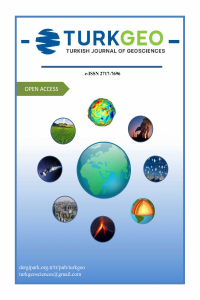Thermal Anomaly Detection of Industrial Zones with MNF and ICA
Thermal Anomaly Detection of Industrial Zones with MNF and ICA
Land surface temperature, Thermal anomaly, Minimum noise fraction Independent component analysis,
___
- Coolbaugh, M.F., Kratt, C., Fallacaro, A., Calvin, W.M. ,Taranik, J.V. (2007). Detection of geothermal anomalies using advanced spaceborne thermal emission and reflection radiometer (ASTER) thermal infrared images at Bradys Hot Springs, Nevada, USA. Remote Sensing of Environment, (106) 3, 350-359.
- Coutts, A. M., Harris, R. J., Phan, T., Livesley, S. J., Williams, N. S., Tapper, N. J. (2016). Thermal infrared remote sensing of urban heat: Hotspots, vegetation, and an assessment of techniques for use in urban planning. Remote Sensing of Environment, 186, 637-651.
- Handcock, R.N., Torgersen, C.E., Cherkauer, K.A., Gillespie, A.R., Tockner, K., Faux, R.N. Tan, J. (2012). Thermal infrared remote sensing of water temperature in riverine landscapes. Fluvial remote sensing for science and management, (85) 113.
- Jensen, J.R. (2020, October 16). Thermal Infrared Remote Sensing Department of Geography, Lecture Notes, University of South Carolina. Retrieved from www.gers.uprm.edu/geol6225/pdfs/06_thermal_rs.pdf.
- Kuenzer, C., Zhang, J., Li, J., Voigt, S., Mehl, H., Wagner, W. (2007). Detecting unknown coal fires: synergy of automated coal fire risk area delineation and improved thermal anomaly extraction. International Journal of Remote Sensing, 28(20), 4561-4585.
- Moore, G., Paine, R. (2014). Quantifying urban-rural temperature differences for industrial complexes using thermal satellite data. AECOM: accessed, 15, 2018.
- Meyer, D., Dawn, S., Barbara B., Lowell, J. (2015). Advanced Spaceborne Thermal Emission and Reflection Radiometer Level 1 Precision Terrain Corrected Registered At-Sensor Radiance (AST_L1T) Product. Algorithm Theoretical Basis Document. No. 2015-1171. US Geological Survey.
- Ndossi, M.I., Avdan, U. (2016). Inversion of land surface temperature (LST) using Terra ASTER data: A comparison of three algorithms. Remote Sensing, 8(12), 993.
- Rasul, A., Heiko, B., Claire, S., John, R., Bashir, A., José A. S., Manat, S., Qihao, W. (2017). A Review on remote sensing of urban heat and cool islands. Land 6, (2) 38.
- Tiangco, M.A., Lagmay, M.F., Argete, J. (2008). ASTER‐based study of the night‐time urban heat island effect in Metro Manila. International Journal of Remote Sensing 29, no. 10: 2799-2818.
- Xia, H., Chen, Y., Quan, J. (2018). A simple method based on the thermal anomaly index to detect industrial heat sources. International journal of applied earth observation and geoinformation, 73, 627-637.
- Wei, C., Zhang, Y., Guo, X., Hui, S., Qin, M., Zhang, Y. (2013). Thermal Infrared Anomalies of Several Strong Earthquakes. The Scientific World Journal, https://doi.org/10.1155/2013/208407
- Başlangıç: 2020
- Yayıncı: Süleyman Sefa BİLGİLİOĞLU
Thermal Anomaly Detection of Industrial Zones with MNF and ICA
Investigation of Disasters with Different InSAR Methods
Bekir GÜNDOĞDU, Hediye ERDOĞAN, Osman OKTAR
Bawallah Musa ADESOLA, Adiat Kola ABDUL-NAFİU, Akinlalu Ayokunle ADEWALE, Ilugbo STEPHEN, Akinluyi Francis OMOWONUOLA, Benjami Odey OMANG, Oyedele Akintunde AKİNOLA, Omosuyi Oluwole GREGORY, Aigbedion ISAAC
Unmanned Aerial Vehicle (UAV) Data Documentation of Cultural Heritage Availability: 1001 Church
